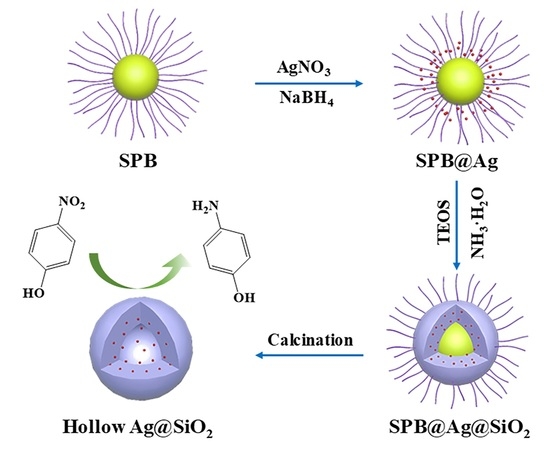Spherical Polyelectrolyte Brushes as Templates to Prepare Hollow Silica Spheres Encapsulating Metal Nanoparticles
Abstract
:1. Introduction
2. Materials and Methods
2.1. Materials
2.2. Preparation of SPB
2.3. Preparation of Hollow Ag@SiO2 and Au@SiO2
2.4. Catalytic Reactions with Hollow Ag@SiO2
2.5. Characterization
3. Results
3.1. Preparation and Characterization of Ag@SiO2
3.2. Catalytic Performance of Ag@SiO2
3.3. Synthesis of Hollow Au@SiO2 Nanoparticles
4. Conclusions
Supplementary Materials
Author Contributions
Funding
Acknowledgments
Conflicts of Interest
References
- Li, Y.H.; Li, N.; Pan, W.; Yu, Z.Z.; Yang, L.M.; Tang, B. Hollow Mesoporous Silica Nanoparticles with Tunable Structures for Controlled Drug Delivery. ACS Appl. Mater. Interfaces 2017, 9, 2123–2129. [Google Scholar] [CrossRef] [PubMed]
- Destito, P.; Sousa-Castillo, A.; Couceiro, J.R.; Lopez, F.; Correa-Duarte, M.A.; Mascarenas, J.L. Hollow Nanoreactors for Pd-Catalyzed Suzuki-Miyaura Coupling and O-Propargyl Cleavage Reactions in Bio-Relevant Aqueous Media. Chem. Sci. 2019, 10, 2598–2603. [Google Scholar] [CrossRef] [PubMed] [Green Version]
- Xu, Y.; Fei, J.; Li, G.; Yuan, T.; Xu, X.; Li, J. Nanozyme-Catalyzed Cascade Reactions for Mitochondria-Mimicking Oxidative Phosphorylation. Angew. Chem. Int. Edit. 2019, 58, 5572–5576. [Google Scholar] [CrossRef]
- Cheng, X.W.; Zhao, H.C.; Huang, W.F.; Chen, J.Y.; Wang, S.X.; Dong, J.P.; Deng, Y.H. Rational Design of Yolk-Shell Cuo/Silicalite-1@mSiO2 Composites for a High-Performance Nonenzymatic Glucose Biosensor. Langmuir 2018, 34, 7663–7672. [Google Scholar] [CrossRef]
- Xu, P.; Liang, J.; Cao, X.Y.; Tang, J.G.; Gao, J.; Wang, L.Y.; Shao, W.; Gao, Q.W.; Teng, Z.G. Facile Synthesis of Monodisperse of Hollow Mesoporous SiO2 Nanoparticles and in-Situ Growth of Ag Nanoparticles for Antibacterial. J. Colloid Interface Sci. 2016, 474, 114–118. [Google Scholar] [CrossRef] [PubMed]
- Li, Y.S.; Shi, J.L. Hollow-Structured Mesoporous Materials: Chemical Synthesis, Functionalization and Applications. Adv. Mater. 2014, 26, 3176–3205. [Google Scholar] [CrossRef] [PubMed]
- Bao, Y.; Shi, C.H.; Wang, T.; Li, X.L.; Ma, J.Z. Recent Progress in Hollow Silica: Template Synthesis, Morphologies and Applications. Microporous Mesoporous Mat. 2016, 227, 121–136. [Google Scholar] [CrossRef]
- Zhu, W.; Chen, Z.; Pan, Y.; Dai, R.Y.; Wu, Y.; Zhuang, Z.B.; Wang, D.S.; Peng, Q.; Chen, C.; Li, Y.D. Functionalization of Hollow Nanomaterials for Catalytic Applications: Nanoreactor Construction. Adv. Mater. 2019, 31, 1800426. [Google Scholar] [CrossRef]
- Du, W.X.; Liu, T.Z.; Xue, F.F.; Chen, Y.; Chen, Q.; Luo, Y.; Cai, X.J.; Ma, M.; Chen, H.R. Confined Nanoparticles Growth within Hollow Mesoporous Nanoreactors for Highly Efficient Mri-Guided Photodynamic Therapy. Chem. Eng. J. 2020, 379, 122251. [Google Scholar] [CrossRef]
- Prieto, G.; Tüysüz, H.; Duyckaerts, N.; Knossalla, J.; Wang, G.-H.; Schüth, F. Hollow Nano- and Microstructures as Catalysts. Chem. Rev. 2016, 116, 14056–14119. [Google Scholar] [CrossRef]
- Deng, Y.; Yue, Q.; Sun, J.; Kang, Y. Recent Advance in Interfacial Assembly Growth of Mesoporous Silica on Magnetite Particles. Angew. Chem. Int. Edit. 2019. [Google Scholar] [CrossRef] [PubMed]
- Li, B.W.; Zeng, H.C. Formation Combined with Intercalation of Ni and Its Alloy Nanoparticles within Mesoporous Silica for Robust Catalytic Reactions. ACS Appl. Mater. Interfaces 2018, 10, 29435–29447. [Google Scholar] [CrossRef] [PubMed]
- Zhang, L.Y.; Wang, T.T.; Yang, L.; Liu, C.; Wang, C.G.; Liu, H.Y.; Wang, Y.A.; Su, Z.M. General Route to Multifunctional Uniform Yolk/Mesoporous Silica Shell Nanocapsules: A Platform for Simultaneous Cancer-Targeted Imaging and Magnetically Guided Drug Delivery. Chem. Eur. J. 2012, 18, 12512–12521. [Google Scholar] [CrossRef] [PubMed]
- Yue, Q.; Zhang, Y.; Wang, C.; Wang, X.Q.; Sun, Z.K.; Hou, X.F.; Zhao, D.Y.; Deng, Y.H. Magnetic Yolk-Shell Mesoporous Silica Microspheres with Supported Au Nanoparticles as Recyclable High-Performance Nanocatalysts. J. Mater. Chem. A 2015, 3, 4586–4594. [Google Scholar] [CrossRef]
- Qiao, Z.A.; Huo, Q.S.; Chi, M.F.; Veith, G.M.; Binder, A.J.; Dai, S. A “Ship-in-a-Bottle” Approach to Synthesis of Polymer Dots@Silica or Polymer Dots@Carbon Core-Shell Nanospheres. Adv. Mater. 2012, 24, 6017–6021. [Google Scholar] [CrossRef]
- Li, K.; Wei, J.; Yu, H.; Xu, P.; Wang, J.; Cohen, S.M.; Wang, J.; Yin, H.; Zhou, S. Generic Method for Preparing Hollow Mesoporous Silica Catalytic Nanoreactors with Metal Oxide Nanoparticles inside Their Cavities. Angew. Chem. Int. Edit. 2018, 57, 16458–16463. [Google Scholar] [CrossRef]
- Li, W.Q.; Ge, X.; Zhang, H.; Ding, Q.Q.; Ding, H.L.; Zhang, Y.X.; Wang, G.Z.; Zhang, H.M.; Zhao, H.J. Hollow Mesoporous SiO2 Sphere Nanoarchitectures with Encapsulated Silver Nanoparticles for Catalytic Reduction of 4-Nitrophenol. Inorg. Chem. Front. 2016, 3, 663–670. [Google Scholar] [CrossRef]
- Tian, M.; Long, Y.; Xu, D.; Wei, S.Y.; Dong, Z.P. Hollow Mesoporous Silica Nanotubes Modified with Palladium Nanoparticles for Environmental Catalytic Applications. J. Colloid Interface Sci. 2018, 521, 132–140. [Google Scholar] [CrossRef]
- Ni, X.J.; Hao, J.F.; Zhao, Y.Q.; Yang, C.; Sun, P.D.; Wang, C.X.; Li, Y.X. A Simple and General Approach for the Decoration of Interior Surfaces of Silica Hollow Microspheres with Noble Metal Nanoparticles and Their Application in Catalysis. Inorg. Chem. Front. 2017, 4, 1634–1641. [Google Scholar] [CrossRef]
- Sanchez-Iglesias, A.; Claes, N.; Solis, D.M.; Taboada, J.M.; Bals, S.; Liz-Marzan, L.M.; Grzelczak, M. Reversible Clustering of Gold Nanoparticles under Confinement. Angew. Chem. Int. Edit. 2018, 57, 3183–3186. [Google Scholar] [CrossRef]
- Wang, D.P.; Zeng, H.C. Creation of Interior Space, Architecture of Shell Structure, and Encapsulation of Functional Materials for Mesoporous SiO2 Spheres. Chem. Mat. 2011, 23, 4886–4899. [Google Scholar] [CrossRef]
- Sarkar, D.; Sen, D.; Nayak, B.K.; Mazumder, S.; Ghosh, A. Spray-Dried Encapsulated Starch and Subsequent Synthesis of Carbon-Silica Core-Shell Micro-Granules. Colloid Surf. A Physicochem. Eng. Asp. 2017, 529, 696–704. [Google Scholar] [CrossRef]
- Hao, N.J.; Nie, Y.; Xu, Z.; Closson, A.B.; Usherwood, T.; Zhang, J.X.J. Microfluidic Continuous Flow Synthesis of Functional Hollow Spherical Silica with Hierarchical Sponge-Like Large Porous Shell. Chem. Eng. J. 2019, 366, 433–438. [Google Scholar] [CrossRef]
- Xu, P.Y.; Li, K.J.; Yu, H.B.; Stuart, M.A.C.; Wang, J.Y.; Zhou, S.H. One-Pot Syntheses of Porous Hollow Silica Nanoreactors Encapsulating Rare Earth Oxide Nanoparticles for Methylene Blue Degradation. Ind. Eng. Chem. Res. 2019, 58, 3726–3734. [Google Scholar] [CrossRef]
- Lu, Y.; Ballauff, M. Spherical Polyelectrolyte Brushes as Nanoreactors for the Generation of Metallic and Oxidic Nanoparticles: Synthesis and Application in Catalysis. Prog. Polym. Sci. 2016, 59, 86–104. [Google Scholar] [CrossRef]
- Wang, S.Y.; Chen, K.M.; Li, L.; Guo, X.H. Binding between Proteins and Cationic Spherical Polyelectrolyte Brushes: Effect of Ph, Ionic Strength, and Stoichiometry. Biomacromolecules 2013, 14, 818–827. [Google Scholar] [CrossRef]
- Wang, W.; Li, L.; Henzler, K.; Lu, Y.; Wang, J.; Han, H.; Tian, Y.; Wang, Y.; Zhou, Z.; Lotze, G. Protein Immobilization onto Cationic Spherical Polyelectrolyte Brushes Studied by Small Angle X-ray Scattering. Biomacromolecules 2017, 18, 1574–1581. [Google Scholar] [CrossRef]
- Yang, Q.; Li, L.; Zhao, F.; Wang, Y.; Ye, Z.; Guo, X. Generation of MnO2 Nanozyme in Spherical Polyelectrolyte Brush for Colorimetric Detection of Glutathione. Mater. Lett. 2019, 248, 89–92. [Google Scholar] [CrossRef]
- Qu, Z.; Xu, H.; Gu, H. Synthesis and Biomedical Applications of Poly ((Meth)Acrylic Acid) Brushes. ACS Appl. Mater. Interfaces 2015, 7, 14537–14551. [Google Scholar] [CrossRef]
- Schrinner, M.; Ballauff, M.; Talmon, Y.; Kauffmann, Y.; Thun, J.; Möller, M.; Breu, J. Single Nanocrystals of Platinum Prepared by Partial Dissolution of Au-Pt Nanoalloys. Science 2009, 323, 617–620. [Google Scholar] [CrossRef]
- Liu, J.J.; Wang, J.; Zhu, Z.M.; Li, L.; Guo, X.H.; Lincoln, S.F.; Prud′homme, R.K. Cooperative Catalytic Activity of Cyclodextrin and Ag Nanoparticles Immobilized on Spherical Polyelectrolyte Brushes. Aiche J. 2014, 60, 1977–1982. [Google Scholar] [CrossRef]
- Zhu, Z.; Guo, X.; Wu, S.; Zhang, R.; Wang, J.; Li, L. Preparation of Nickel Nanoparticles in Spherical Polyelectrolyte Brush Nanoreactor and Their Catalytic Activity. Ind. Eng. Chem. Res. 2011, 50, 13848–13853. [Google Scholar] [CrossRef]
- Polzer, F.; Kunz, D.A.; Breu, J.; Ballauff, M. Formation of Ultrathin Birnessite-Type Nanoparticles Immobilized on Spherical Polyelectrolyte Brushes. Chem. Mat. 2010, 22, 2916–2922. [Google Scholar] [CrossRef]
- Han, H.Y.; Li, L.; Wang, W.H.; Tian, Y.C.; Wang, Y.W.; Wang, J.Y.; von Klitzing, R.; Guo, X.H. Core-Shell-Corona Silica Hybrid Nanoparticles Templated by Spherical Polyelectrolyte Brushes: A Study by Small Angle X-Ray Scattering. Langmuir 2017, 33, 9857–9865. [Google Scholar] [CrossRef] [PubMed]
- Yang, Q.S.; Li, L.; Zhao, F.; Han, H.Y.; Wang, W.H.; Tian, Y.C.; Wang, Y.W.; Ye, Z.S.; Guo, X.H. Hollow Silica-Polyelectrolyte Composite Nanoparticles for Controlled Drug Delivery. J. Mater. Sci. 2019, 54, 2552–2565. [Google Scholar] [CrossRef]
- Huang, S.B.; Yu, X.J.; Dong, Y.M.; Li, L.; Guo, X.H. Spherical Polyelectrolyte Brushes: Ideal Templates for Preparing Ph-Sensitive Core-Shell and Hollow Silica Nanoparticles. Colloid Surf. A Physicochem. Eng. Asp. 2012, 415, 22–30. [Google Scholar] [CrossRef]
- Guo, X.; Weiss, A.; Ballauff, M. Synthesis of Spherical Polyelectrolyte Brushes by Photoemulsion Polymerization. Macromolecules 1999, 32, 6043–6046. [Google Scholar] [CrossRef]
- Liu, X.C.; Xu, Y.S.; Wang, X.H.; Shao, M.F.; Xu, J.; Wang, J.; Li, L.; Zhang, R.; Guo, X.H. Stable and Efficient Loading of Silver Nanoparticles in Spherical Polyelectrolyte Brushes and the Antibacterial Effects. Colloid Surf. B Biointerfaces 2015, 127, 148–154. [Google Scholar] [CrossRef]
- Zhu, Y.; Chen, K.M.; Wang, X.; Guo, X.H. Spherical Polyelectrolyte Brushes as a Nanoreactor for Synthesis of Ultrafine Magnetic Nanoparticles. Nanotechnology 2012, 23, 265601. [Google Scholar] [CrossRef]
- Wu, X.T.; Li, L.; Zhang, L.Y.; Wang, T.T.; Wang, C.G.; Su, Z.M. Multifunctional Spherical Gold Nanocluster Aggregate@Polyacrylic Acid@Mesoporous Silica Nanoparticles for Combined Cancer Dual-Modal Imaging and Chemo-Therapy. J. Mat. Chem. B 2015, 3, 2421–2425. [Google Scholar] [CrossRef]
- Shaik, F.; Zhang, W.; Niu, W. A Generalized Method for the Synthesis of Ligand-Free M@SiO2 (M = Ag, Au, Pd, Pt) Yolk-Shell Nanoparticles. Langmuir 2017, 33, 3281–3286. [Google Scholar] [CrossRef] [PubMed]
- Cui, G.J.; Sun, Z.B.; Li, H.Z.; Liu, X.N.; Liu, Y.; Tian, Y.X.; Yan, S.Q. Synthesis and Characterization of Magnetic Elongated Hollow Mesoporous Silica Nanocapsules with Silver Nanoparticles. J. Mater. Chem. A 2016, 4, 1771–1783. [Google Scholar] [CrossRef]
- Zhou, M.Y.; Du, X.; Li, W.K.; Li, X.Y.; Huang, H.W.; Liao, Q.L.; Shi, B.Y.; Zhang, X.J.; Zhang, M.Q. One-Pot Synthesis of Redox-Triggered Biodegradable Hybrid Nanocapsules with a Disulfide-Bridged Silsesquioxane Framework for Promising Drug Delivery. J. Mat. Chem. B 2017, 5, 4455–4469. [Google Scholar] [CrossRef] [PubMed]
- Veisi, H.; Razeghi, S.; Mohammadi, P.; Hemmati, S. Silver Nanoparticles Decorated on Thiol-Modified Magnetite Nanoparticles (Fe3O4/SiO2-Pr-S-Ag) as a Recyclable Nanocatalyst for Degradation of Organic Dyes. Mater. Sci. Eng. C Mater. Biol. Appl. 2019, 97, 624–631. [Google Scholar] [CrossRef]
- Jia, H.; Schmitz, D.; Ott, A.; Pich, A.; Lu, Y. Cyclodextrin Modified Microgels as “Nanoreactor” for the Generation of Au Nanoparticles with Enhanced Catalytic Activity. J. Mater. Chem. A 2015, 3, 6187–6195. [Google Scholar] [CrossRef]
- Wu, S.; Kaiser, J.; Guo, X.; Li, L.; Lu, Y.; Ballauff, M. Recoverable Platinum Nanocatalysts Immobilized on Magnetic Spherical Polyelectrolyte Brushes. Ind. Eng. Chem. Res. 2012, 51, 5608–5614. [Google Scholar] [CrossRef]
- Lu, Y.; Mei, Y.; Schrinner, M.; Ballauff, M.; Moller, M.W. In Situ Formation of Ag Nanoparticles in Spherical Polyacrylic Acid Brushes by Uv Irradiation. J. Phys. Chem. C 2007, 111, 7676–7681. [Google Scholar] [CrossRef]
- Hao, N.J.; Li, L.F.; Tang, F.Q. Facile Preparation of Ellipsoid-Like Mcm-41 with Parallel Channels Along the Short Axis for Drug Delivery and Assembly of Ag Nanoparticles for Catalysis. J. Mater. Chem. A 2014, 2, 11565–11568. [Google Scholar] [CrossRef]
- Nemanashi-Maumela, M.; Nongwe, I.; Motene, R.C.; Davids, B.L.; Meijboom, R. Au and Ag Nanoparticles Encapsulated within Silica Nanospheres Using Dendrimers as Dual Templating Agent and Their Catalytic Activity. Mol. Catal. 2017, 438, 184–196. [Google Scholar] [CrossRef]
- Chen, Y.; Yang, D.; Yoon, Y.J.; Pang, X.; Wang, Z.; Jung, J.; He, Y.; Harn, Y.W.; He, M.; Zhang, S. Hairy Uniform Permanently—Ligated Hollow Nanoparticles with Precise Dimension Control and Tunable Optical Properties. J. Am. Chem. Soc. 2017, 139, 12956–12967. [Google Scholar] [CrossRef]
- Chen, Y.; Wang, Q.H.; Wang, T.M. One-Pot Synthesis of M (M = Ag, Au)@SiO2 Yolk-Shell Structures Via an Organosilane-Assisted Method: Preparation, Formation Mechanism and Application in Heterogeneous Catalysis. Dalton Trans. 2015, 44, 8867–8875. [Google Scholar] [CrossRef] [PubMed]

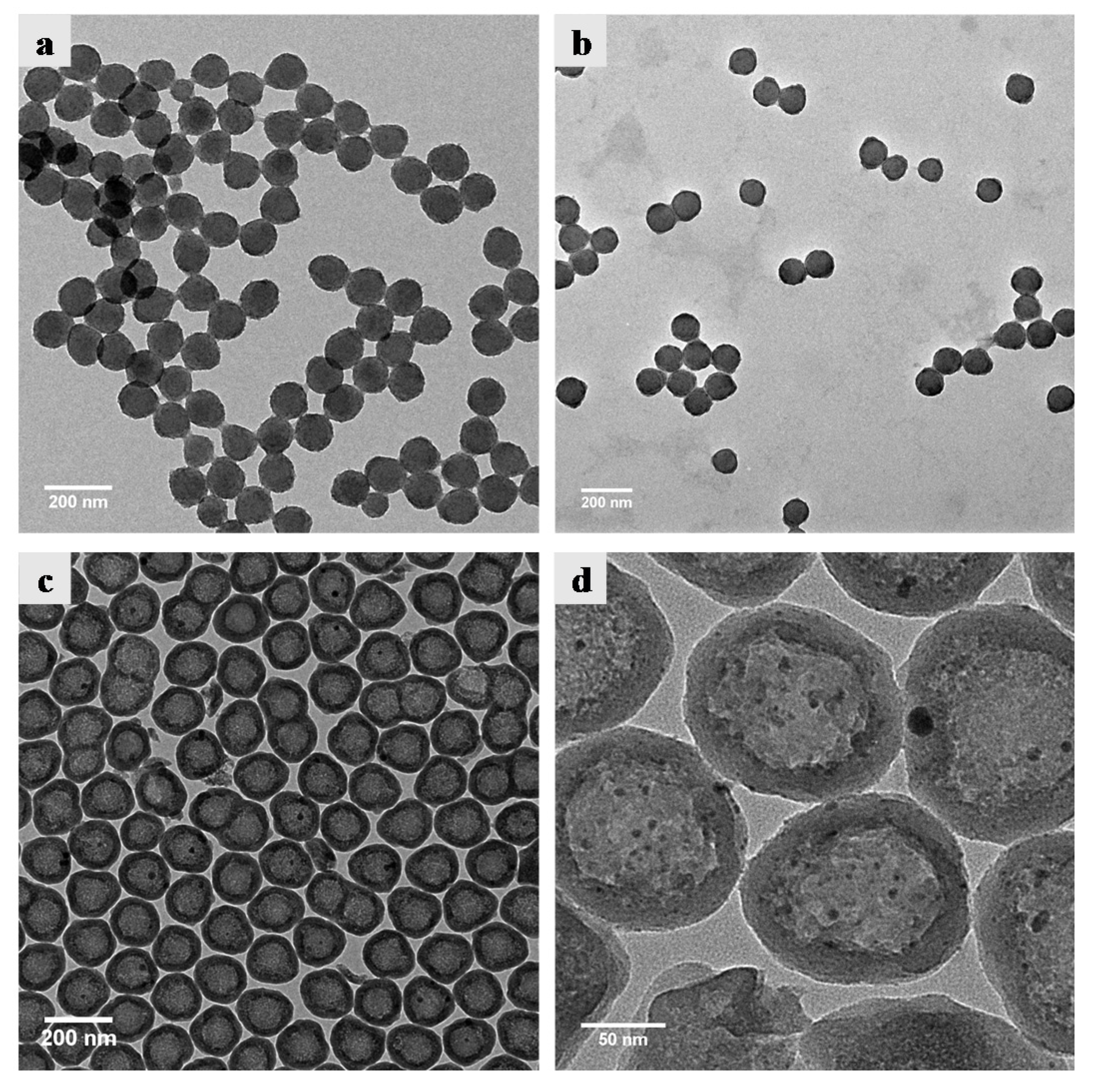
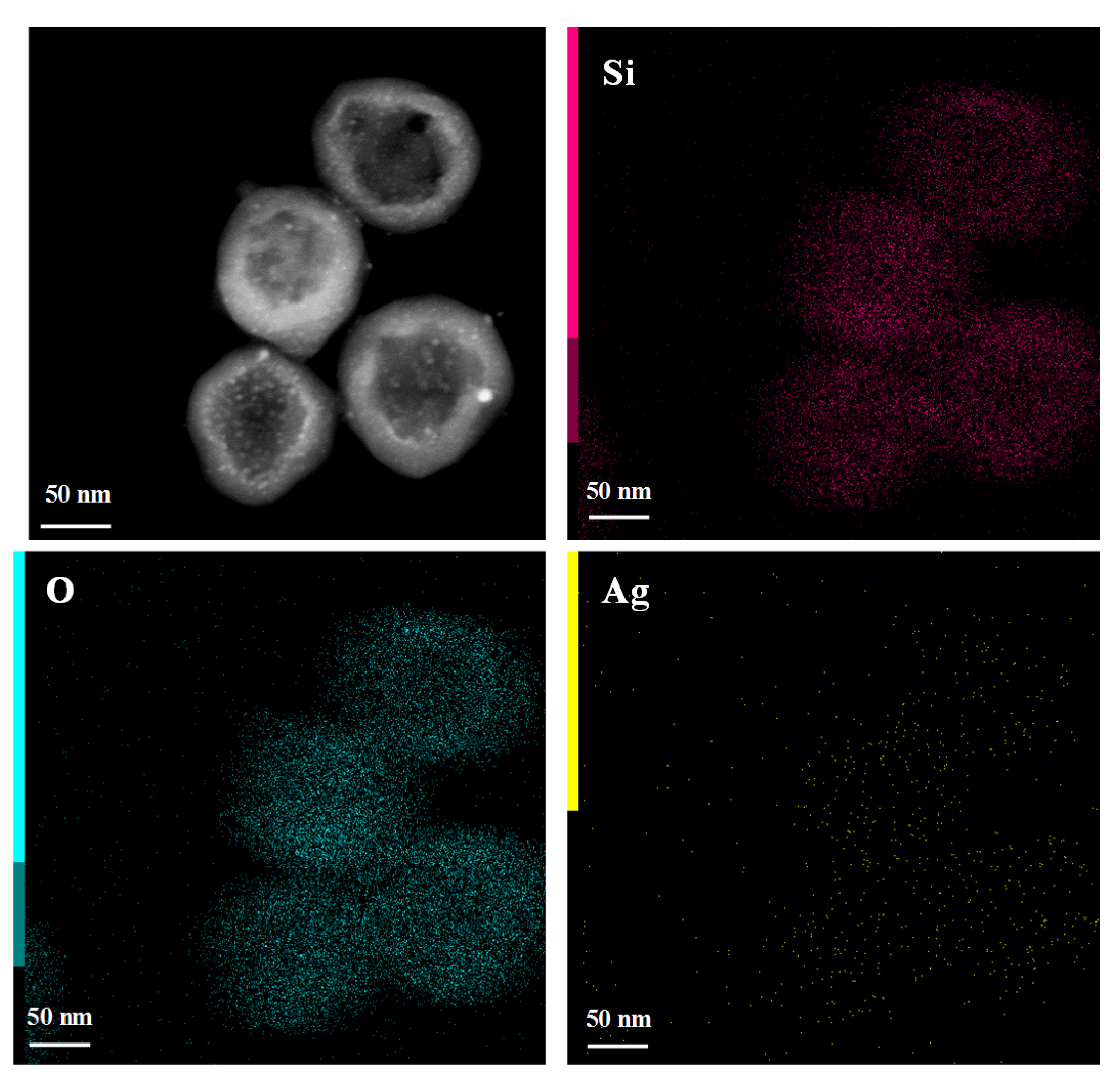
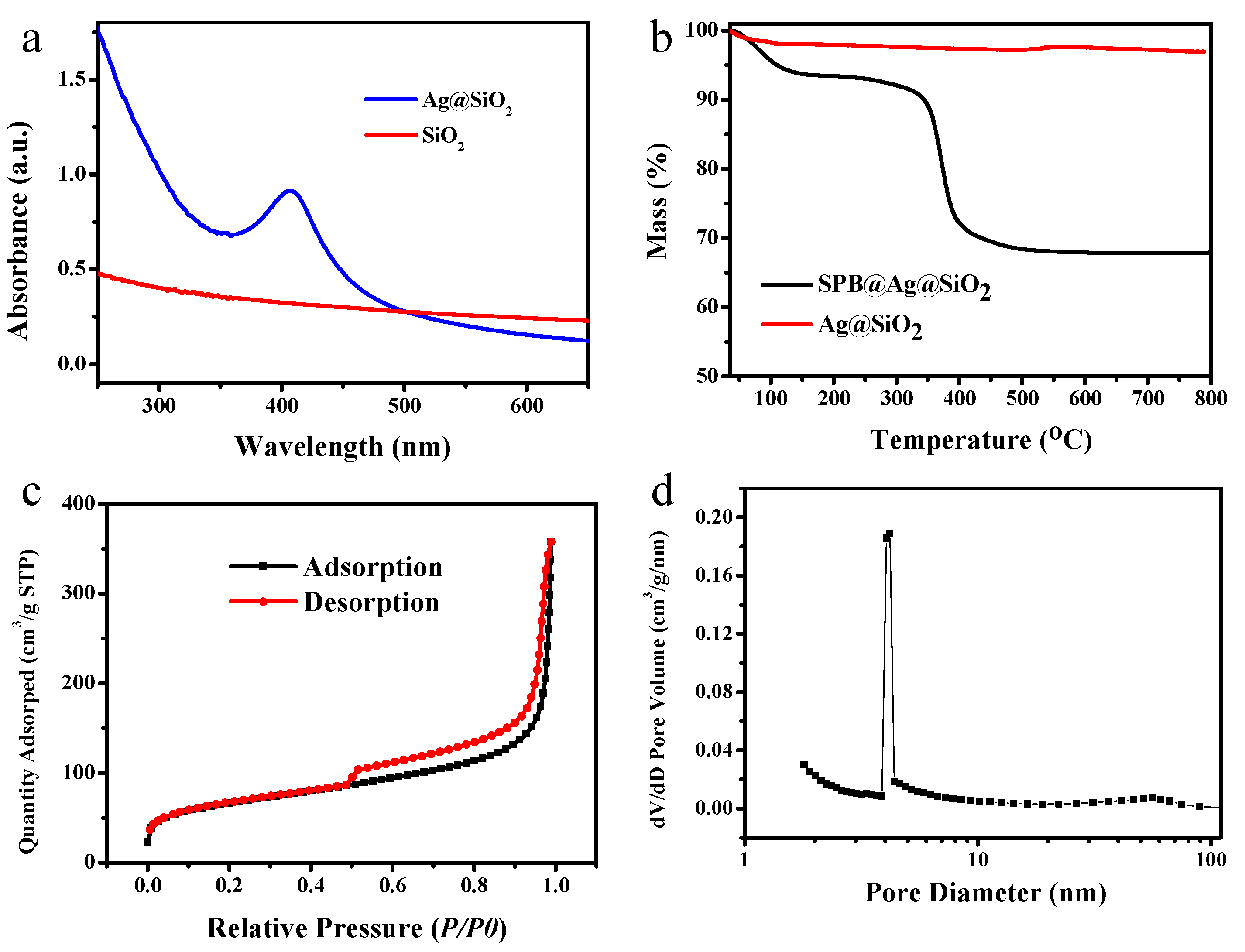
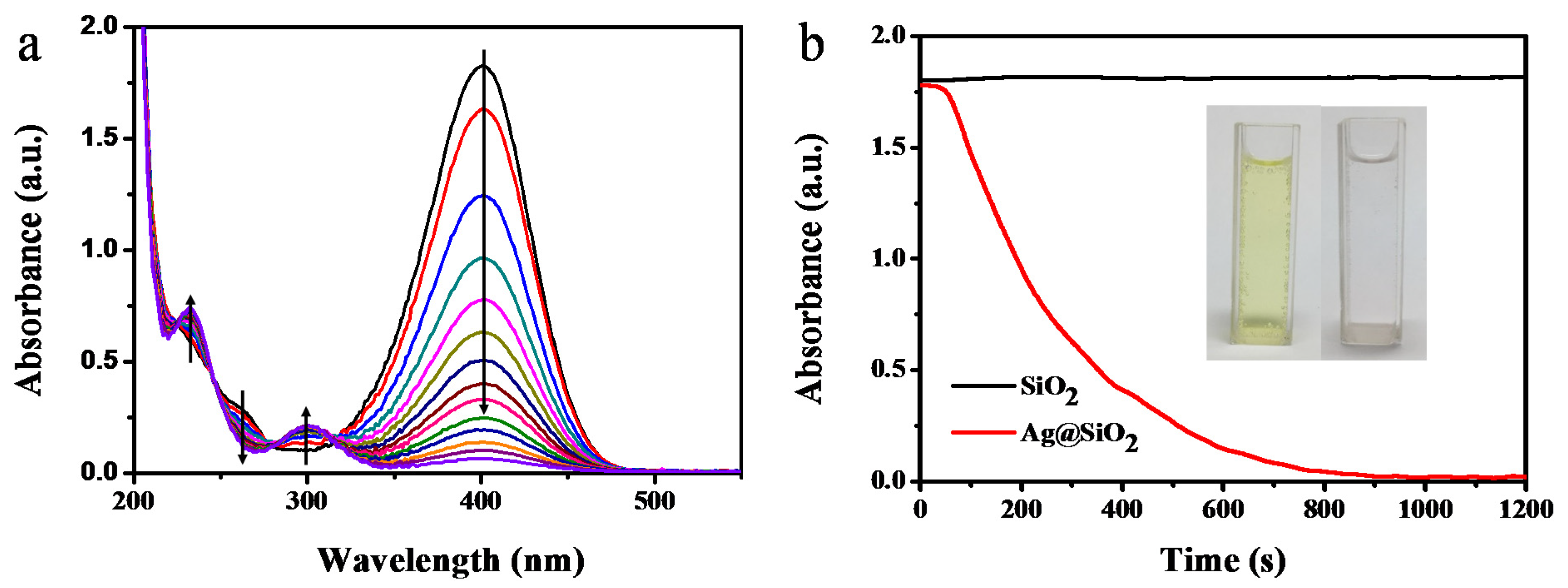

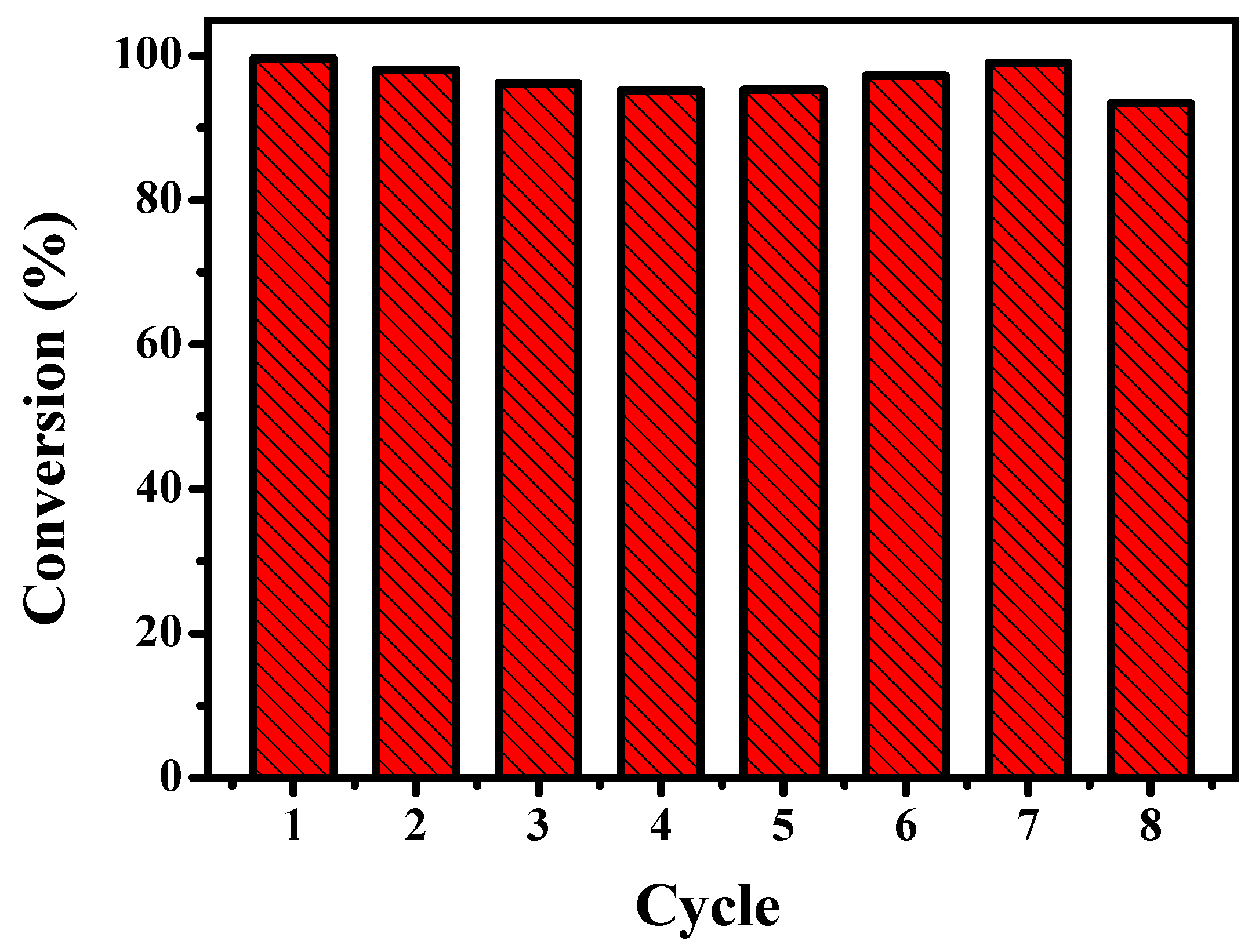
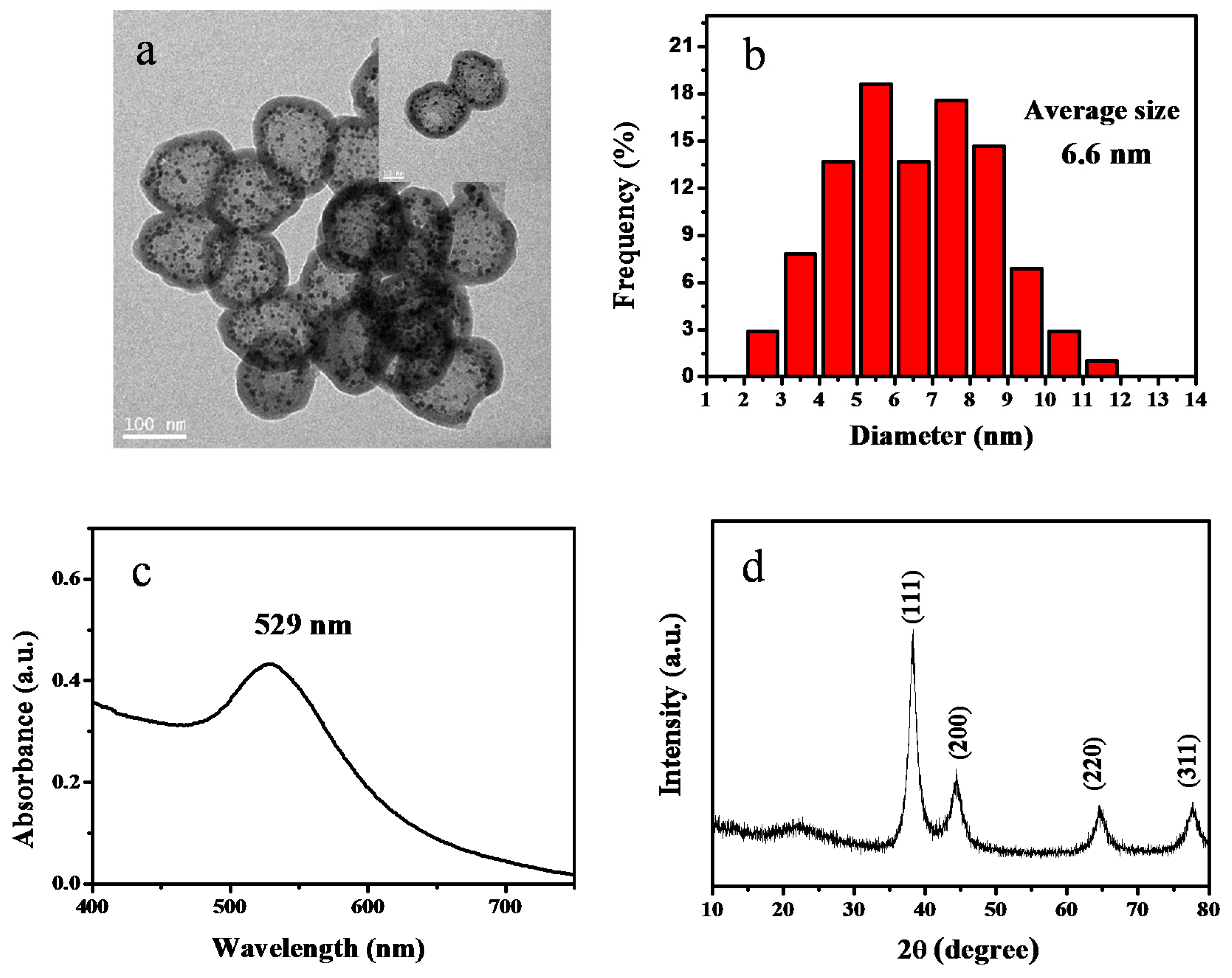
© 2020 by the authors. Licensee MDPI, Basel, Switzerland. This article is an open access article distributed under the terms and conditions of the Creative Commons Attribution (CC BY) license (http://creativecommons.org/licenses/by/4.0/).
Share and Cite
Yang, Q.; Li, L.; Zhao, F.; Wang, Y.; Ye, Z.; Hua, C.; Liu, Z.; Bohinc, K.; Guo, X. Spherical Polyelectrolyte Brushes as Templates to Prepare Hollow Silica Spheres Encapsulating Metal Nanoparticles. Nanomaterials 2020, 10, 799. https://doi.org/10.3390/nano10040799
Yang Q, Li L, Zhao F, Wang Y, Ye Z, Hua C, Liu Z, Bohinc K, Guo X. Spherical Polyelectrolyte Brushes as Templates to Prepare Hollow Silica Spheres Encapsulating Metal Nanoparticles. Nanomaterials. 2020; 10(4):799. https://doi.org/10.3390/nano10040799
Chicago/Turabian StyleYang, Qingsong, Li Li, Fang Zhao, Yunwei Wang, Zhishuang Ye, Chen Hua, Zhiyong Liu, Klemen Bohinc, and Xuhong Guo. 2020. "Spherical Polyelectrolyte Brushes as Templates to Prepare Hollow Silica Spheres Encapsulating Metal Nanoparticles" Nanomaterials 10, no. 4: 799. https://doi.org/10.3390/nano10040799




